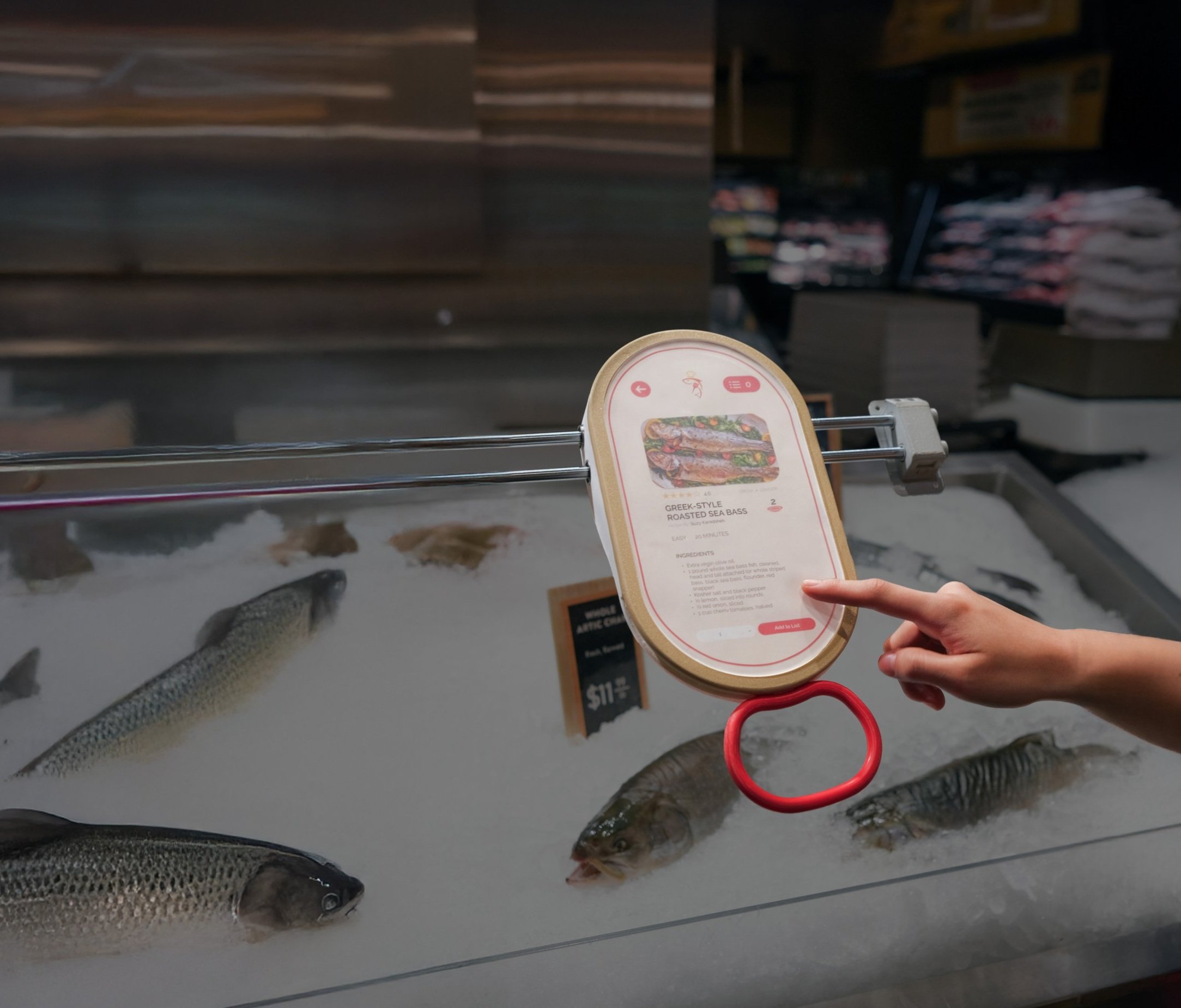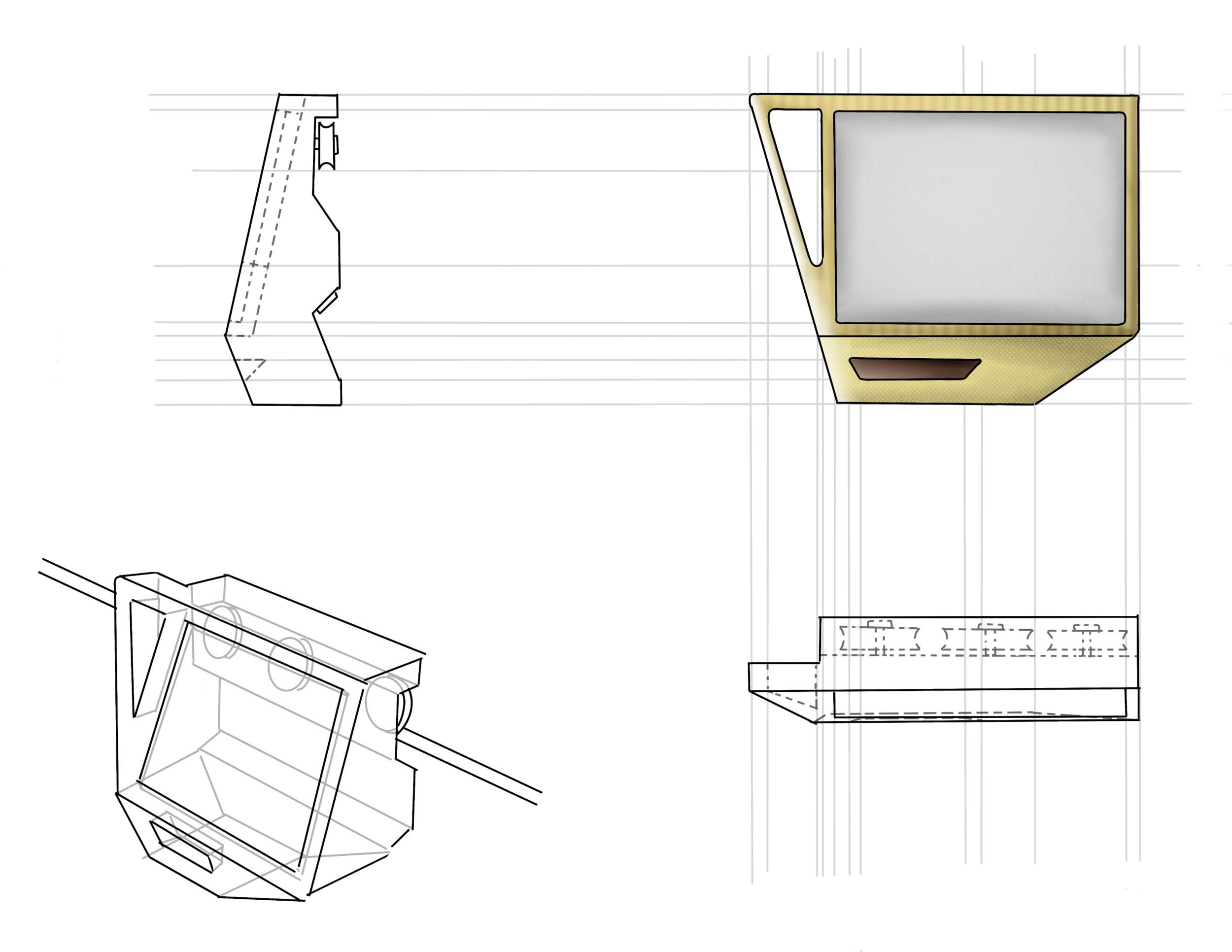
Engage with seafood like you never have before
Field: Product Design / Interaction Design
Duration: 4 Months Year: 2024
Software Used
Seafood waste represents a critical challenge in the U.S. supermarkets, where nearly 40% of seafood intended for sale is not consumed, largely due to economic strategies and consumer preferences for fish fillets over whole fish. SeaReels aims to address this issue by transforming seafood shopping into a n interactive and educational experience, encouraging customers to embrace sustainable consumption practices.
Pivoting handle
Designed for flexibility, the handle adjusts effortlessly to accommodate both left- and right-handed users, ensuring ease of use.
Interative touchscreen
The user-friendly touchscreen interface provides an intuitive and engaging browsing experience.
Modular rod mount
Securely attaches to the display, with a detachable design for hassle-free maintenance and repairs.
User Interface Flow
Click to Display
Seafood in the u.s.
Observations in U.S. supermarkets reveal an overwhelming preference for fish fillets on display, while other parts of the fish are often discarded or entirely absent from shelves. This selective offering reflects consumer demand but contributes significantly to seafood waste, as whole fish are underutilized, and valuable portions go unappreciated or unseen by shoppers.
Survey
based on 72 responses reside in the U.S.
Contextualizing the Seafood Sales in the U.S. Supermarkets
Political
Sustainable Fishing Regulations: Magnuson-Stevens Act promotes sustainable fishing to prevent overfishing, influencing seafood variety in supermarkets
Supermarket Standards: FDA and NOAA enforce quality and safety standards for seafood, ensuring it meets strict criteria before reaching consumers
Economic
Price and Profitability: Fillets yield higher profit margins due to processing costs, meeting demand for convenience but impacting whole fish sales
Waste-Related Loss: Seafood waste contributes to economic losses, with seafood accounting for 6.1% of grocery waste
Social
Consumer Preferences: 65% of consumers prefer fillets over whole fish, primarily for convenience
Lack of Preparation Knowledge: 58% of consumers avoid whole fish due to unfamiliarity with preparation methods
Technological
Preservation and Packaging: Modified Atmosphere Packaging (MAP) extends seafood shelf life, helping reduce spoilage
Automation in Processing: Automation increases efficiency, enabling supermarkets to stock a broader range of seafood
Legal
Labeling Requirements: FDA and USDA require seafood origin and species labeling, helping consumers make informed choices
Food Safety Standards: Strict FDA and NOAA guidelines prevent contamination and ensure seafood quality in supermarkets
Environmental
High Seafood Waste: Nearly 40% of seafood intended for sale goes uneaten, leading to resource depletion and emissions
Sustainability of Whole Fish: Encouraging whole fish consumption could reduce waste, maximize resource
Interview
Who
Total 8 participants who have purchased seafood in the past weeks, including 3 White, 2 Black, 2 Hispanic, and 1 Asian.
Overview
Where
The interviews were conducted over Zoom or in person, depending on participants’ availability and preference
Why
Most of them had filled out the survey and agreed to participate in the interview.
My initial goal was to deepen my understanding of consumer and seller behaviors, preference, and attitudes toward seafood to identity pain points in the journey of seafood purchasing. After interviewing 3 participants, I discovered that customer’s cultural background, level of education, and how the seafood is presented at the store stood out. I then adjusted my questions to delve deeper in these areas, ultimately gather insights from 14 participants.
Key Insights
Preference of Fillets Driven by Misconception of “Freshness” and Quality”
Many participants, particularly White and Black respondents, assumed fillets were the freshest or highest-quality part of the fish, seeing whole fish as “leftovers” or lower quality. This misconception points to a lack of familiarity with the seafood supply chain and a bias toward certain cuts.
Cultural Familiarity
Hispanic and Asian participants were more comfortable with whole fish, associating it with traditional dishes, while other participants felt unprepared or intimidated by the idea of handling a whole fish. However, for day-to-day meals, they also defaulted to fillets for convenience that prevails in routine purchases.
Perceived Complexity of Whole Fish Preparation Inhibits Experimentation
Interviewees expressed feeling that cooking whole fish required more skill than they possessed, fearing they would “ruin” the meal. This anxiety reflects not only unfamiliarity but also a strong hesitation to experiment due to fear of failure, pointing to a need for accessible, confidence-boosting resources.
Growing Interest in Sustainability
Participants who had encountered sustainability messaging (e.g., labels, information boards) at specialty stores or farmers’ markets were more aware of seafood waste and sustainable practices than those who shopped at larger supermarkets.
Barrier Based on Perception Than Fact
Surprisingly, several participants assumed that buying a whole fish would be significantly more expensive than purchasing fillets, despite the opposite often being true.
Problem Statement
In U.S. supermarkets, nearly 40% of seafood goes uneaten due to preferences for fillets over whole fish, driven by convenience, unfamiliarity with alternative cuts, and profitability-focused displays. This waste impacts environmental sustainability, calling for social and communication pathways to engage consumers, reshape perceptions, and promote the value of whole fish and lesser-known cuts.
Value Opportunity Analysis
Key VOs
Confidence
Power
Comfort
Personality & Social
Enabling
Product Requirement
Independence
The product must empower consumers to make informed decisions about selecting and preparing seafood with minimal reliance on external guidance.
The product must reduce barriers to choosing whole fish and alternative cuts by offering clear and accessible support that enhances consumer trust and capability.
The product must highlight the environmental benefits of sustainable seafood choices, enabling consumers to feel their decisions contribute positively to global sustainability.
The product must create an intuitive and welcoming experience that minimizes confusion, making the process of purchasing and engaging with seafood stress-free and enjoyable.
The product must celebrate diverse seafood traditions, connecting consumers from various cultural backgrounds and fostering shared appreciation for sustainability and community.
The product must offer tools, systems, or resources that simplify decision-making and enhance accessibility, ensuring a smooth and effective user experience for all.
Customer Journey
Final Product Opportunity
The final product opportunity is to create an interactive and educational experience that transforms the seafood shopping process into a more engaging, approachable, and sustainable journey. By addressing the critical barriers of consumer unfamiliarity, intimidation, and lack of confidence in handling whole fish, this product should simplifies and streamlines the process of selecting and preparing seafood.
The opportunity focuses on empowering customers with real-time guidance, personalized recipe suggestions, and educational insights to reshape perceptions of whole fish and encourage sustainable consumption. Ultimately, this product should foster confidence and curiosity as well as integrate seamlessly with existing supermarket systems to make shopping a more playful and enrich experience.
Design Concept
Concept I: Subscription Packaging
Concept II: Fish display overlay
Concept III: Restaurant Gadget
A seafood subscription box designed to simplify the process of handling seafood and preparing ingredients. Customers receive a seasonal selection of fish, complete with traceable origin information, ensuring transparency and confidence in their choices. Each box includes recipes tailored for convenience, making it easy to prepare and enjoy the health benefits of fresh, sustainably sourced seafood.
Fish display overlay is a device positioned above the display shelf, providing real-time information about the seafood available for sale. Alternatively, it can also involve a portable tablet-based device that allows customers to freely navigate the display shelves while accessing detailed fish insights. Both aim to alleviate customer intimidation, making the selection process more approachable and engaging.
This gadget, placed in restaurants, allows customers ordering fish dishes to observe how their meal is prepared by the chef. For those inspired to try it at home, recipe cards are available to take. Alternatively, the concept could include a dish mat with a unique QR code linked to the fish dish. Scanning the code provides a live feed of the preparation and cooking process, helping customers gain insights into techniques they may be unfamiliar with.



User Interface Wireframing
Final Concept Sketch
Form Refinement
The form was refined to accommodate customer preferences, allowing the handle to be easily grasped with either the left or right hand. The handle’s placement adjusts automatically based on the direction the customer pulls or pushes the device
CAD Modeling
The handle’s pivoting mechanism was refined through a series of tests to ensure optimal functionality and structural integrity
The rod mount ensures the railings are securely installed while allowing for easy maintenance and repairs when needed




































